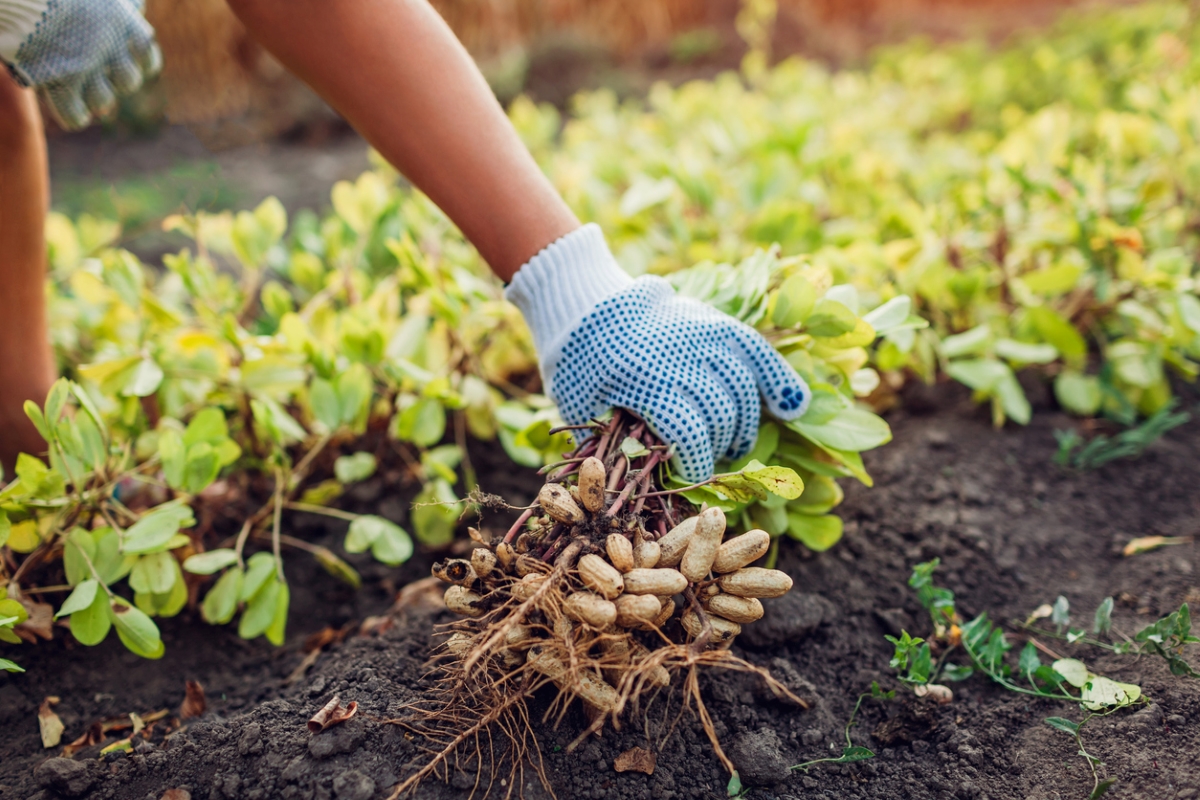

We may earn revenue from the products available on this page and participate in affiliate programs. Learn More ›
No, peanuts don’t grow on trees, nor are there peanut bushes. Once called goober peas, peanuts are actually annual legumes, like peas. They just happen to produce their pods underground.
When contemplating how to grow peanuts, now considered to be a superfood, keep in mind that the peanut growing season requires at least 4 months of summerlike temperatures. Peanuts can be difficult to raise successfully in northern and mountainous growing zones. However, gardeners there may succeed in harvesting at least a small crop by starting the plants indoors in spring or by covering them in autumn.
RELATED: How to Grow Your Own Food
Growing Peanuts at a Glance
Common Name: Peanut
Scientific Name: Arachis hypogaea
Hardiness Zone: Annual
Soil: Light, sandy, humus rich
Light: Full sun (8 hours)
Water: High
Food: Low-nitrogen fertilizer
Propagation: Seed
Safety: Dangerous for allergic people
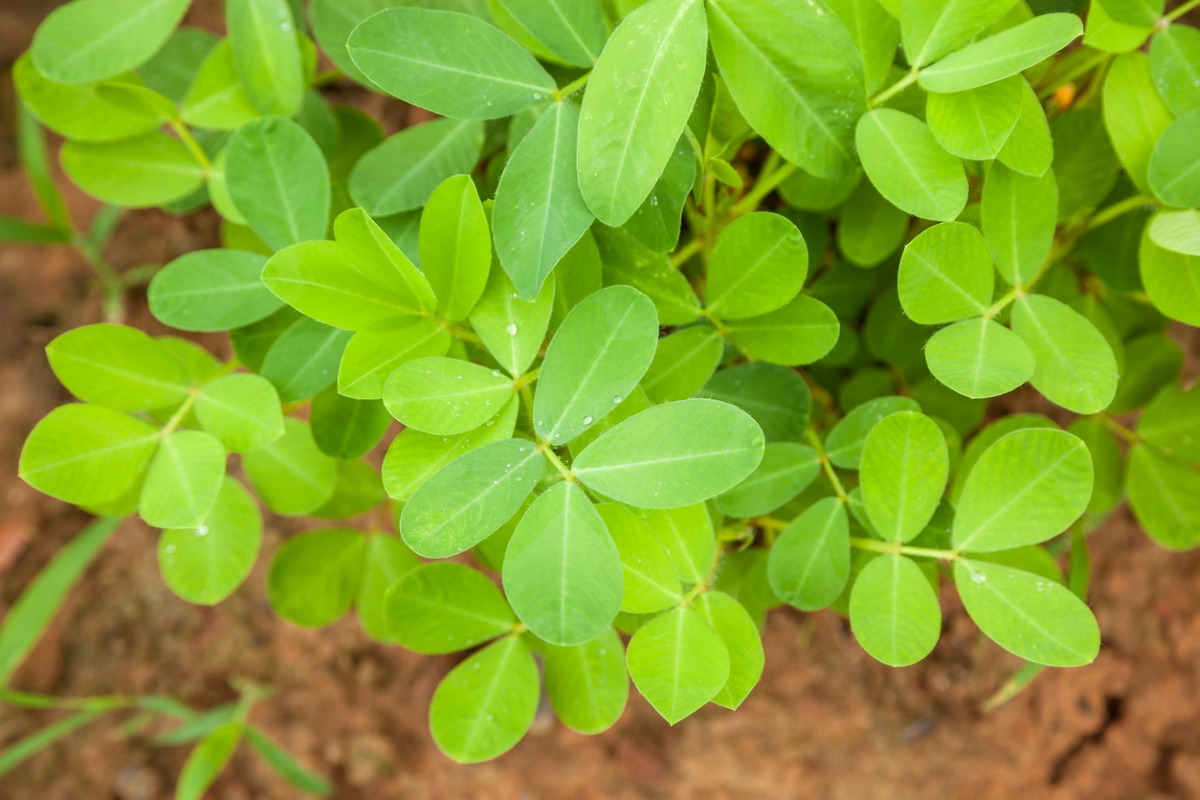
Peanut Plant Characteristics
Native to South America, peanut plants grow 1 to 2 feet tall with foliage resembling clover and self-pollinating yellow blooms shaped similar to those of peas. After a flower is fertilized, its fertilized ovary, called a “peg,” buds and forms a small stalk that grows downward. The peg plants itself a couple inches deep in the ground, where a pod will be produced. Once the nuts in its pods ripen, a peanut plant begins to die back.
According to the National Peanut Board, traditional U.S. peanut growing zones include parts of Alabama, Arkansas, Florida, Georgia, Louisiana, Missouri, Mississippi, North Carolina, New Mexico, Oklahoma, South Carolina, Texas, and Virginia, and each plant can produce 30 to 40 peanuts. The Australian peanut tree (Sterculia quadrifida) isn’t part of the peanut species and doesn’t actually produce peanuts, but rather seeds with a flavor resembling goober peas. So, if you want to grow genuine peanuts, you’ll have to dig them in more ways than one!
Recommended Peanut Varieties
When growing peanuts, selecting a variety to plant depends on the type of soil in which they will grow and personal preference. Length of growing season is a critical consideration in cooler areas. Below are examples of the four peanut types (Virginia, Valencia, Spanish, and Runner):
- Valencia Tennessee Red: This Valencia variety matures in only 110 days with two to five kernels per pod; Valencia peanuts are known as easy to grow and for their sweetness and deep-red skins.
- Early Spanish: Producing even earlier than some Valencia types, Early Spanish can bear a crop in 105 days, with two to three kernels per pod.
- Jumbo Virginia: This peanut cultivar boasts large nuts and takes about 135 days to mature.
- Florunner: Bred in Florida, this runner type produces a higher yield than most runner peanuts. Runners are the most commonly grown varieties, and they require at least 135 days to crop but produce one to two large nuts per pod.
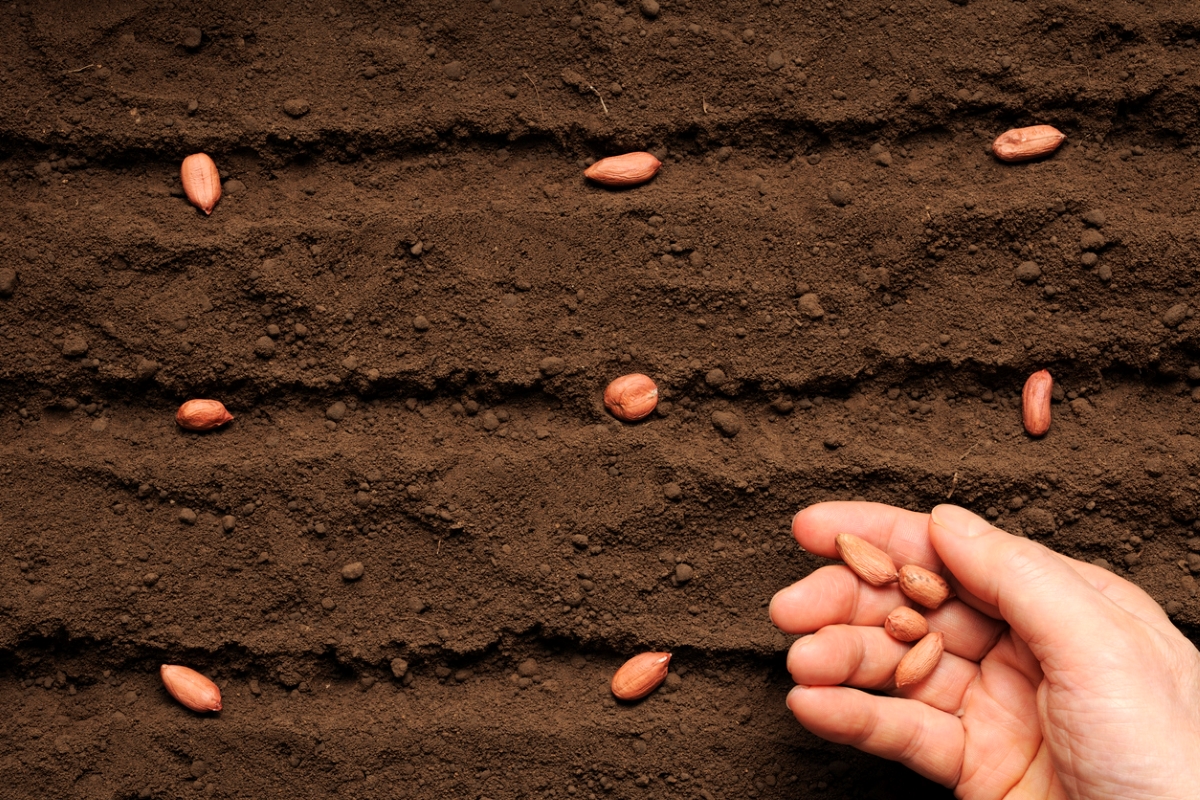
Planting Peanuts
You either can purchase peanut seeds from a seed seller or use raw, unroasted peanuts for your planting.
When is the best time to plant peanuts?
Peanuts germinate best at a soil temperature between 68 and 95 degrees Fahrenheit, so wait until about a month after the last frost to plant them. Alternatively, plant them near a south-facing wall or in another naturally heat-generating position. If necessary, you can start them indoors about a month before you plan to set them outdoors.
Where can peanuts grow?
Choose a location in full sun, where other legumes haven’t grown recently, in fast-draining sandy soil with a pH between 5.8 and 6.2. If you have clay soil, loosen it by digging in an inch or so of compost. Peanuts won’t grow well in hard ground where it’s difficult to set their pegs.
How do you plant peanuts?
Remove raw peanuts from their shells, but don’t remove the paperlike seed coat covering each peanut.
- If possible, treat the seeds with a bacterial inoculant intended for legumes before sowing them.
- Clemson University recommends that you “plant seeds 2 to 3 inches deep in light textured sandy soils and 1½ to 2 inches deep in clay soils.”
- Sow peanut seeds 6 to 12 inches apart in rows 2 to 3 feet apart; you should see peanuts sprouting in 5 to 15 days.
- When the plants are a foot tall, hill them up with 6 inches of soil around the plants.
- Top the plants with a row cover to keep them warm and hasten maturity.
Can you grow peanuts in containers?
If you want to grow peanut plants in containers, the National Peanut Board suggests using a pot 18 to 20 inches across and 18 inches deep for each plant. You will also want to follow some of the recommendations for garden-grown plants, such as hilling them up after a month or so and avoiding high-nitrogen plant foods.
RELATED: What Is Companion Planting and How to Use It in Your Home Garden
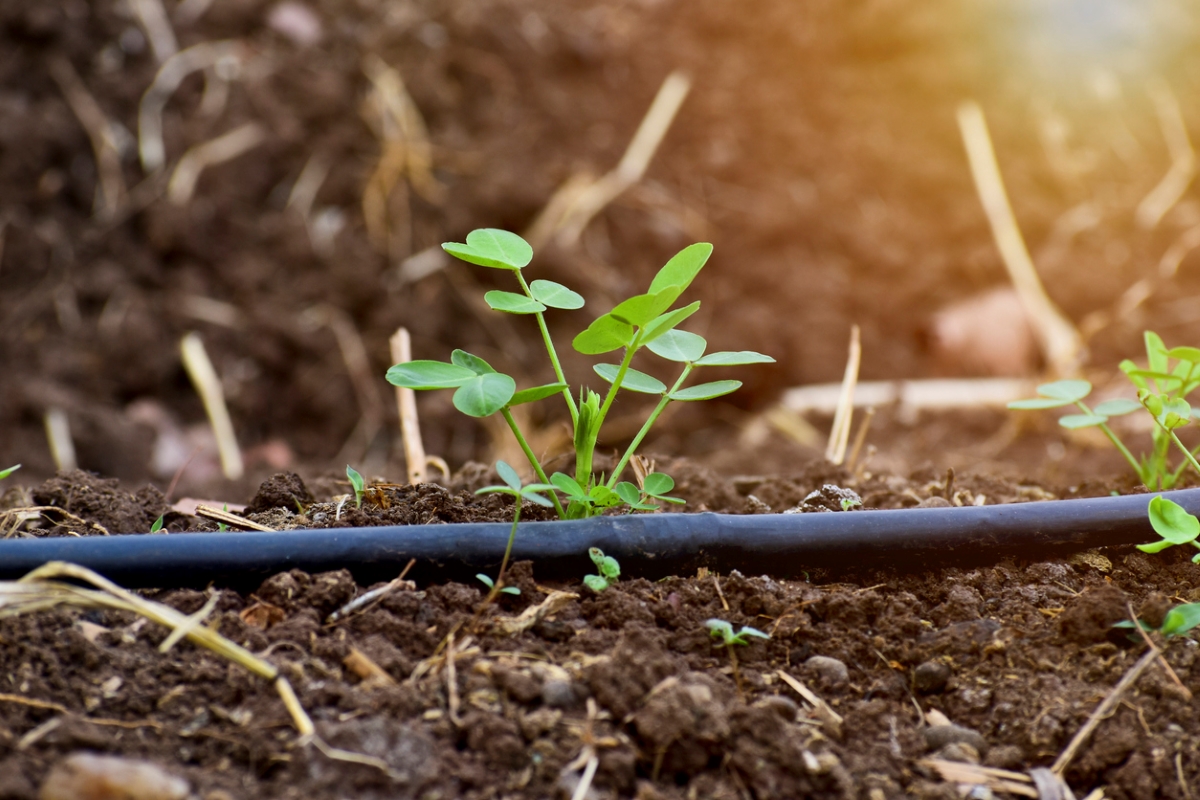
Watering Peanut Plants
Peanut plants will require 1 to 2 inches of water per week via rainfall or irrigation; the exact amount depends on soil type. If possible, avoid overhead watering, which can lead to fungal problems. A mulch of 2 to 4 inches of compost applied after hilling the plants can keep their soil moist and suppress weeds around them. Stop watering the peanuts a couple weeks before you intend to harvest them so the soil will be dry and easy to shake off.
Fertilizing Peanuts
According to Clemson University, “Peanut plants respond better to residual fertility than to directly applied spring fertilizer.” The college goes on to say that it is best to plant peanuts in a spot where another type of well-fertilized crop was grown in the past. This also will help to prevent fertilizer burn when applying fertilizer, a condition to which peanuts are prone.
Since the plants can set their own nitrogen, making them occasionally popular as a cover crop, use a low- or no-nitrogen type of fertilizer if you decide to apply one. Also, mix it thoroughly into the top 6 inches of the soil before you sow seeds rather than applying it directly beneath or above them.
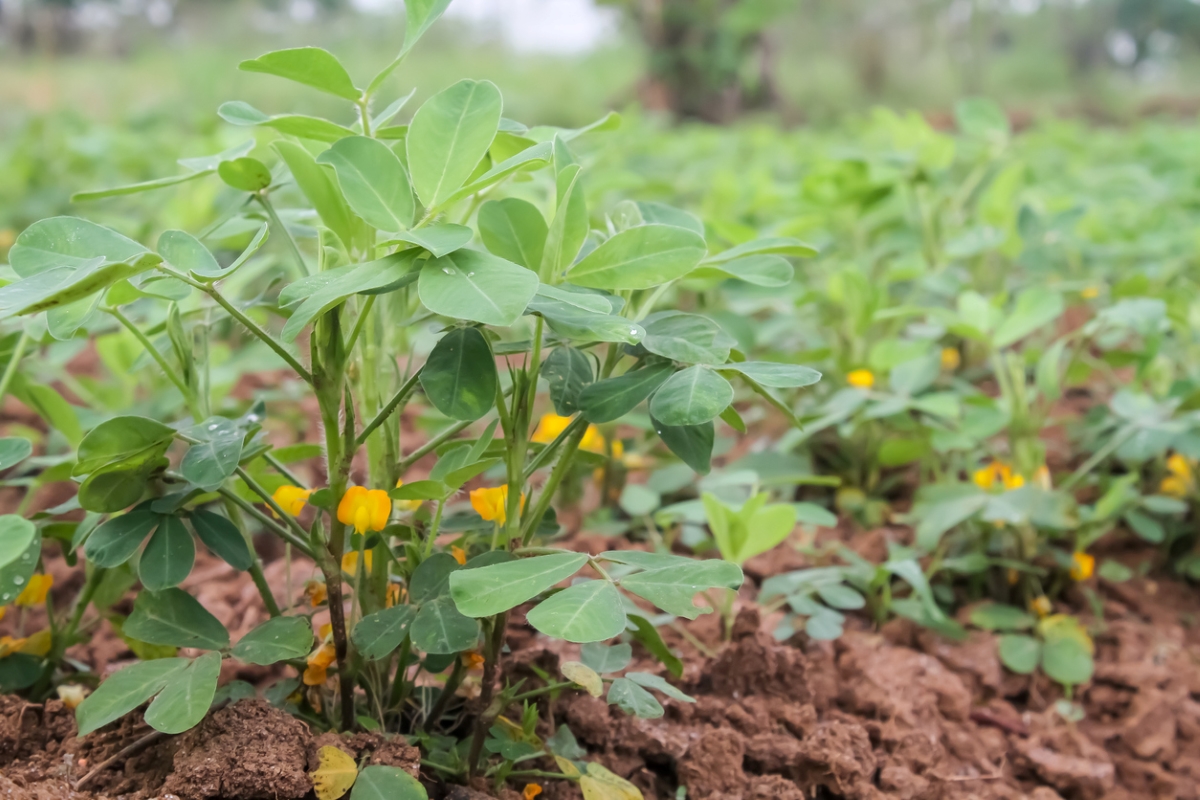
Pollination
The National Peanut Board notes that peanuts are self-pollinating, explaining, “Self-pollination means peanuts do not require outside aid—such as bees, other insects, or the wind—to carry pollen from one plant to another in reproduction.” In other words, the peanut plant flower can fertilize itself via its own stamens and doesn’t need pollen to be carried to it from a different bloom. Pollination is one aspect of peanut plant care with which gardeners need not concern themselves.
Safety Considerations
For most humans and animals, peanuts pose few hazards. In fact, the dried foliage often is fed to livestock as hay. However, people with severe allergies can suffer life-threatening anaphylactic shock if exposed to the proteins in peanuts. It’s definitely not a good idea to grow these plants if any member of your immediate family or social circle has such a sensitivity.
And, yes, even though dogs adore peanuts, it is possible for some of them—and some cats—to be allergic also. In animals, the reaction often takes the form of extreme itching rather than anaphylactic shock.
RELATED: The Best Things You Can Do for Your Garden Soil
Potential Pests and Diseases
Among the worst peanut pests, wireworms (the larvae of click beetles) can eat up a harvest while it still remains underground. Deep disking or tilling before planting may help reduce their populations.
Keep in mind that mice and other rodents like peanuts too, so you may have to protect your crop from them, either while it is still in the ground or while it is drying. Keep an eye on Fido as well to make sure your pet isn’t helping himself to the results of your labors.
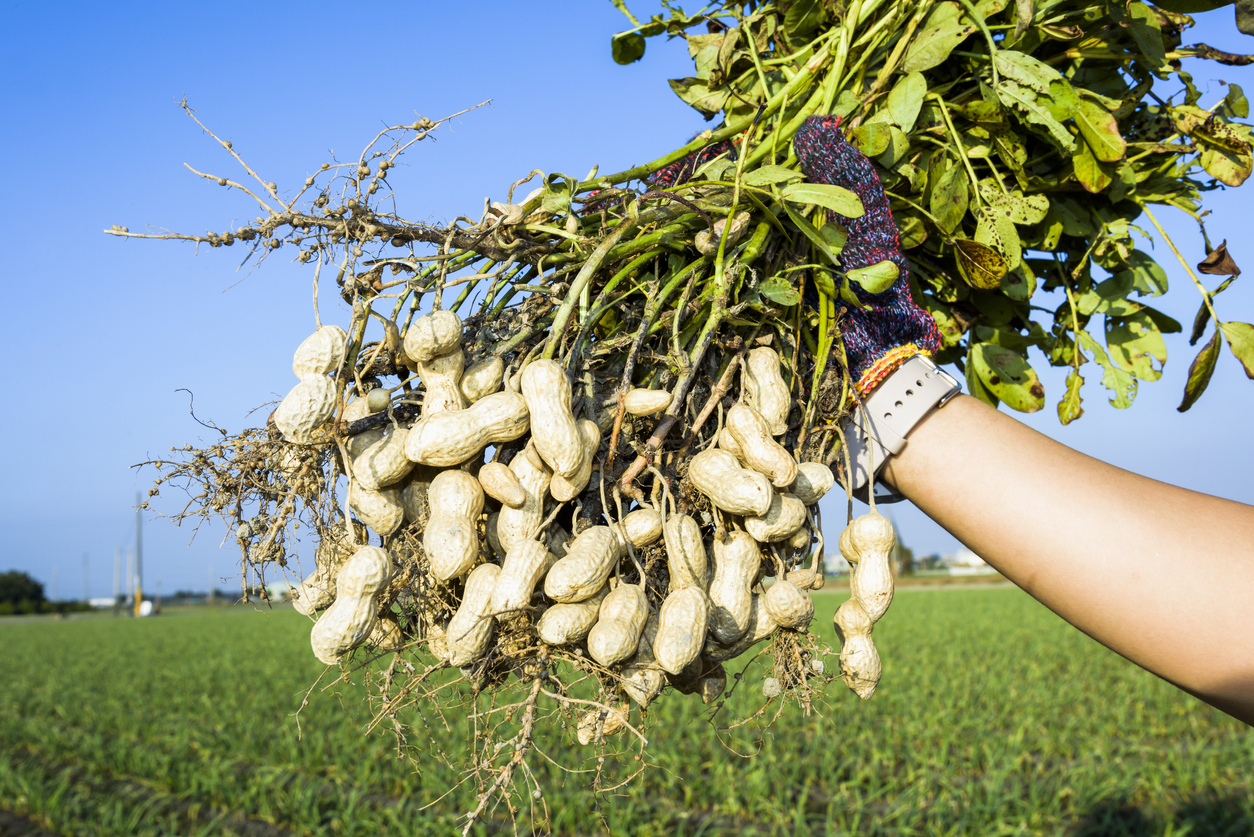
Harvesting Peanuts
The correct time to harvest peanuts will depend on whether you intend to boil or roast them.
When is the best time to harvest peanuts?
You may harvest Valencia peanuts for boiling in as little as 75 to 110 days. They will be green (not fully mature) at that time. If you intend to roast Spanish or Virginia peanuts, wait for 130 to 150 days or so until the plants’ foliage begins to yellow. When that happens, pull up a plant and examine its peanuts. The papery seed coat enclosing them should be dark pink or red rather than white or pale pink.
How do you harvest peanuts?
Keep in mind that once temperatures of 40 degrees Fahrenheit or below have occurred for several days, peanuts aren’t going to mature any further and might as well be harvested.
- Use a garden fork or pitchfork to dig up the plants, shaking away the loose soil.
- If there is no rain in the forecast, allow the plants and attached peanuts to dry on the ground for a week before moving them to a more protected airy site, shielding them from mice or other foragers as needed.
- Dry them for an additional week before stripping off the pods.
- After discarding the wilted foliage, dry the pods for a further 2 weeks.
How do you store peanuts?
If your raw peanuts haven’t molded, you can store them still in their shells in loosely woven containers such as burlap bags and baskets. When placed in a cool, dry location, they should keep for several months. Nuts that have been shelled and roasted and kept at room temperature should be consumed within a month. Those stored in airtight containers in the refrigerator or freezer can keep for up to a year.
Looking for more underground crop plants? Check out our guides on growing carrots, potatoes, and sweet potatoes.
